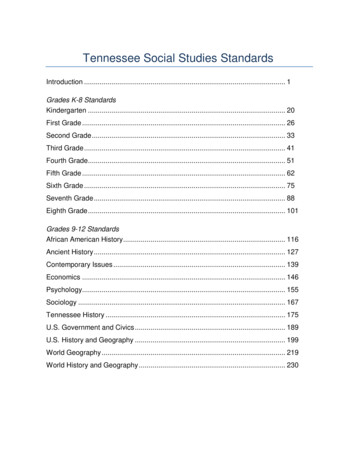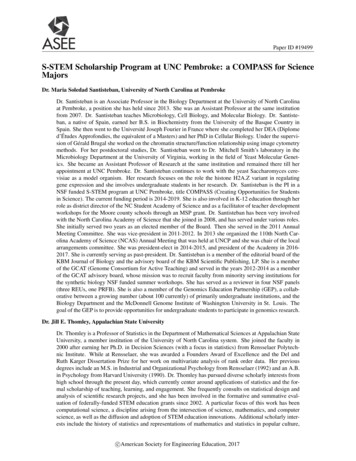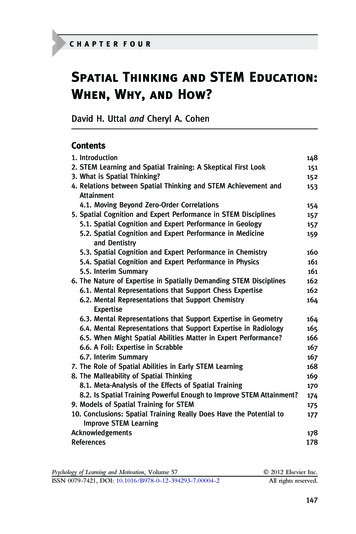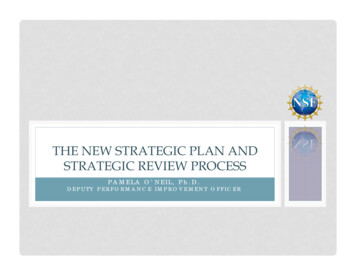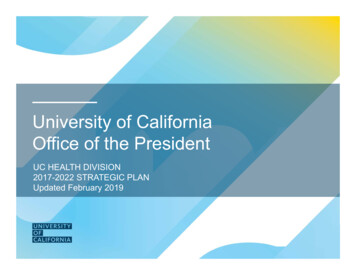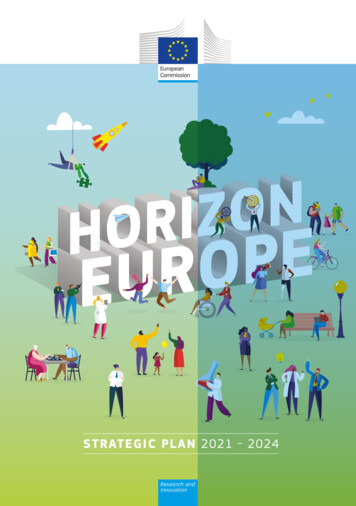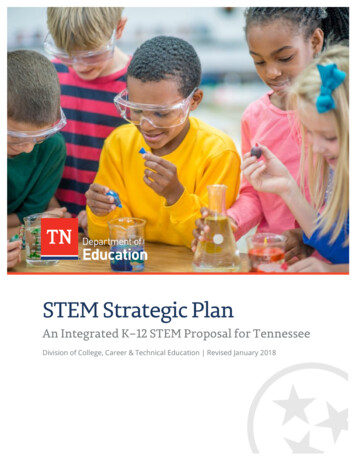
Transcription
[Type here]mathSTEM Strategic PlanAn Integrated K–12 STEM Proposal for TennesseeDivision of College, Career & Technical Education Revised January 2018
Executive SummaryThe need for fully integrated K–12 STEM education in Tennessee has never been more critical.STEM (science, technology, engineering, and math) is the fifth-fastest-growing occupationalcluster in the South and the seventh-largest employer with projected employment of 2.6 millionworkers by 2020. In order to prepare our students to take advantage of the vast opportunitiesin this field, we must equip students with the knowledge and skills to successfully embark upona STEM pathway and ultimately a high-demand STEM-related career. Too many STEM jobs arebeing left unfilled, meaning our graduates are missing valuable opportunities to join one of thefastest growing industries in the nation. STEM education stands as a key strategy to addressthese gaps, provide additional opportunities to Tennessee students, and to strengthenTennessee’s economic future.If Tennessee is to lead the nation in STEM industry growth, it is essential that Tennessee adoptand promote robust STEM-based instruction utilizing Tennessee math and science standards asthe primary focus. By aligning state math and science standards with STEM practices, we canincrease student achievement in STEM learning, expand student access to effective STEMeducators, and build broad-based community awareness for STEM professions. Together,Tennessee can equip students for the STEM careers of the future and lead the nation in STEMtalent development.In June 2014, the Tennessee Department of Education established a STEM Leadership Councilto address the issue of STEM–related gaps. Specifically, the council has examined how toprovide primary and secondary students in Tennessee access and exposure to rigorous STEMrelated learning pathways through the state’s math and science standards. This work is all withthe ultimate goal of postsecondary attainment and the development of a dynamic pipeline offuture STEM professionals who are highly skilled across industries and in academic research.These priorities along with the essential stakeholders who will lead the collaborative statewideapproach are woven throughout this document (Figure 1). This STEM strategic plan will setTennessee on a path to lead the nation in meaningful STEM-based instruction, anchored by thenew rigorous state math and science standards, and ensuring a strengthened position in thenational and global STEM-related industrial fields.Figure 12
Strategic Recommendation SummaryUnder the direction of the STEM Leadership Council and in partnership with the TennesseeDepartment of Education, the following recommendations have been developed to address thefull integration of STEM education in K-12 learning. These recommendations reflect thepromotion of a fully integrated approach, targeting four priority areas to drive the integrativework of state math and science standards with broader STEM-related focuses. These fourpriority areas are: curriculum and instruction, student achievement, educator professionaldevelopment, and community and postsecondary partnerships.Successfully addressing the four priority areas within the K-12 STEMstrategic plan depends heavily on dedicated and integrated scienceinstruction, as mandated by our new science standards to beimplanted during the 2018-19 school year. The Tennessee ScienceStandards require the integration of technology and engineeringwithin and beyond the science context. This, alongside theintentionally aligned mathematics standards will result in a STEMinstructional plan for all students.Curriculum and Instruction 3
Professional Development Community and Postsecondary Partnerships
State of STEM in TennesseeRight now, there is a shortage of qualified STEM job applicants to fill the demand our state has.In order to ensure we have a ready workforce to fill the pipeline of STEM related career needs,we must ensure that Tennessee students are well prepared for the challenges of a STEM career.In order to advance economically, Tennessee is shifting attention to new technology in order to1modernize conventional economic divisions such as agriculture and manufacturing. Failure tomeet this need will lead our state’s STEM-related businesses to seek other means to meetdemand, including moving their companies outside our state or importing talent from outsideour borders.STEM is the fifth fastest growing occupational cluster in the South and the seventh largestemployer, with projections of 2.6 million workers by 2020. STEM jobs are central to theinnovation and technological growth of this state. This in turn makes many policy and businessleaders strong proponents of increasing the STEM-education pipeline. STEM jobs pay well atevery level, presenting graduates with vast opportunities to launch a career and a life. It is atrend that remains consistent across time, making STEM jobs a strong factor in increasing the2broader state tax base.As Tennessee strives to maintain and advance its economic stability and workforce, we mustmake it our goal to increase the number of students who come through and out of K–16education prepared for these high-demand STEM-related careers. Unfortunately, students whochoose to pursue these careers are often inadequately prepared to take on the challengesthese positions demand. Secondary and postsecondary students are often lacking criticalthinking, problem solving, and collaborative skills that are imperative for success. This too oftenaffects their on the job performance. Students often struggle not only with academicknowledge when applying for a job, but they also face challenges involving real worldapplications like problem solving, conducting independent research, and proactively seekingsolutions.1Rosenblum, I., & Kazis, R. (n.d.). Middle-Skill STEM State Policy Framework. Retrieved April 1, 2016, from state-policyframework2Rosenblum, I., & Kazis, R. (n.d.). Middle-Skill STEM State Policy Framework. Retrieved April 1, 2016, from state-policyframework5
As a state, we also recognize that we must close the STEM gap for women and minorities.Women and minority groups represent approximately 70 percent of college students in the3U.S., but receive only 45 percent of the undergraduate degrees awarded in STEM disciplines.STEM is not only the place where the vast majority of the highest paying jobs are found, it isalso the place where the wage gap between men and women is the smallest. Currently, in STEMfields, women earn 92 cents for every dollar earned by men, compared to 77 cents for othernon-STEM fields.Even as STEM careers offer the smallest gender wage disparity, the following sobering statisticsilluminate the urgency to invest more girls and minorities in the field:Infographic Credit to Tata Consultancey Services3Executive Office of the President: President’s Council of Advisors on Science and Technology (2012). “Report To The President Engage To Excel: Producing One MillionAdditional College Graduates With Degrees In Science, Technology, Engineering, and Mathematic. osites/ostp/pcastexecutive-report-final 2-13-12.pdf6
Strategic RecommendationsThe STEM Leadership Council was established in June 2014 to address the issue of STEM–related gaps. The council formed to address how to provide primary and secondary students inTennessee access and exposure to rigorous STEM-related learning pathways leading topostsecondary achievement and the development of a diverse, robust, and dynamic pipeline offuture STEM professionals who are highly skilled across industries and in academic research.(See Appendix A)The following sections provide greater detail concerning the strategic plan recommendations.Each of the four priority areas (Figure 2) reflect the promotion of a fully integrated K–12 STEMapproach reflective of the state’s math and science standards as the central focus to drive thisintegrative work.Figure 2Successfully addressing the four priority areas within the K-12 STEMstrategic plan depends heavily on dedicated and integrated scienceinstruction, as mandated by our new science standards to be implantedduring the 2018-19 school year. The Tennessee Science Standards requirethe integration of technology and engineering within and beyond thescience context. This, alongside the intentionally aligned mathematicsstandards will result in a STEM instructional plan for all students.7
Four Priority Areas for K–12 STEMThe four priority areas, which are reflective of the state’s new math and science standards, areaddressed in depth below outlining the action steps needed to close the STEM academic andskills gaps in Tennessee.8
Priority One: Curriculum and InstructionKey Recommendations Overview:1. Create K–12 modules that utilize the new Tennessee math and science standardsand incorporate STEM instructional practices and career exploration for students2. Provide instructional and community resources for the integration of K-12classroom learning and external-based learning opportunities, focusing onproject-based, hands on learning and applications1. Create K–12 modules that utilize the new Tennessee math and sciencestandards and incorporate STEM instructional practices and careerexploration for studentsWe recognize the importance of creating K-12 modules to ensure development of a seamlessintegration of curriculum incorporating the Tennessee state math and science standards withSTEM practices and career exploration applications. To accomplish this we will:Elementary (K–5)1. Expose students to the content and engaging STEM applications incurriculum using the Tennessee state math and science standards and STEMpracticesa. Consistently incorporate STEM vocabulary and practices aligned withthe literacy expectations of the Tennessee math and sciencestandardsb. Incorporate integrated lesson modules using the Tennessee statemath and science standards highlighting different STEM practices andapplicationsc. Highlight STEM careers within the modules9
2. Develop and coordinate professional development of district and schoolpersonnel responsible for implementing integrated STEM instructiona. Math teachers, science teachers, instructional coaches, and guidancecounselorsMiddle School (6–8)1. Expose students to the content and engaging STEM applications incurriculum using the Tennessee state math and science standards and STEMpracticesa. Continue to develop and apply STEM vocabulary and practices asdirected by the literacy expectations of the Tennessee math andscience standards.b. Incorporate integrated lesson modules using the Tennessee statemath and science standards highlighting different STEM practices andapplicationsc. Incorporate STEM career applications within the integrated modulesi. Create integrated STEM lessons highlighting different careersusing real-world applications emphasis on college and careerreadyii. Develop visual pathways to postsecondary for STEM careersiii. Construct career interest surveysiv. Compose a database of industries for STEM career fairs,industry speakers and tours2. Develop and coordinate professional development of district and schoolpersonnel responsible for implementing the STEM career modulesa. Math teachers, science teachers, instructional coaches, STEMteachers, and guidance counselorsHigh School (9–12)1. Expose students to the content and engaging STEM applications incurriculum using the Tennessee state math and science standards and STEMpracticesa. Continue to develop and apply STEM vocabulary and practices asdirected by the literacy expectations of the Tennessee math andscience standards.b. Incorporate integrated lesson modules using the Tennessee statemath and science standards highlighting different STEM practices andapplicationsd. Incorporate STEM career applications within the integrated modulesi.Create integrated STEM lessons highlighting different careersusing real-world applications emphasis on college and careerreadyii.Develop visual pathways to postsecondary for STEM careersiii.Compose a database of industries for STEM career fairs,industry speakers and tours10
2. Develop and coordinate professional development of district and schoolpersonnel responsible for implementing the STEM career modulesb. Math teachers, science teachers, instructional coaches, STEMteachers, and guidance counselors3. Embed STEM strategies and applications into CTE coursework to ensurestudents are receiving hands-on real-word applications.2. Provide instructional and community resources for the integration of K-12classroom learning and external-based learning opportunities, focusing onproject-based, hands on learning and applicationsWe understand the significance of providing resources that connect the importance ofextending STEM practices and applications beyond the traditional school day. Some examplesmay include, but not limited to:Elementary (K–5)1. Provide external learning opportunities:a. Promote SkillsUSA ’s “Jump into STEM” career exploration curriculumb. Advocate for career exploration online resourcesMiddle School (6–8)1. Provide external learning opportunities:a. Advocate for career exploration online resourcesb. Promote Technology Student Association for middle schoolHigh School (9–12)1. Provide external learning opportunities:a. Promote Technology Student Association for high schoolb. Advocate for SkillsUSA for high schoolc. Advocate for career exploration online resources11
Priority Two: AchievementKey Recommendations Overview:1. Develop integrative guidance for districts that incorporate math and science studentachievement along with other components essential to the development of strongschool STEM cultures and focuses2. Create a designation, in partnership with the Tennessee STEM Innovation Network,which recognizes schools for promising practices in integrative STEM instruction1. Develop integrative guidance for districts that incorporate math andscience student achievement along with other components essential to thedevelopment of strong school STEM cultures and focusesWe acknowledge the relevance of ensuring the STEM components, which are already present inthe state’s math and science standards, are taught in a cohesive, innovative fashion such thatstudent achievement scores increase and are representative of an integrative STEM learningapproach. To accomplish this we will:1. Create rubrics assessing STEM practices and allow students (K-12) todemonstrate proficiency as aligned with the Tennessee math and sciencestandards12
2. Create a designation, in partnership with the Tennessee STEM InnovationNetwork, which recognizes schools for promising practices in integrativeSTEM instructionWe respect the value of recognizing schools that value the importance of aligning STEMpromising practices with Tennessee state math and science standards to increase studentachievement. To accomplish this we will:1. Create a STEM school designation sub-committee from the STEM LeadershipCouncil consisting of effective STEM school leaders and representatives fromacross the state2. Create an application process and an evaluation rubric based on the criteria setby the committee3. Provide recommendations in partnership with the Tennessee STEM InnovationNetwork and the Tennessee Department of Education for which schools and/orprograms are recommended for designation4. Offer technical assistance to applicant schools and/or programs on STEMintegration5. Provide a platform for an annual recognition event13
Priority Three: Professional DevelopmentKey Recommendations Overview:1. Provide and support consistent funding for high-quality STEM professional developmentin conjunction with the rollout and ongoing support of the state math and sciencestandards2. Adopt guidelines for quality STEM educator professional development3. Create quality STEM micro-credentials to provide STEM educators a standard for highquality STEM teacher practices4. Implement a system of periodic reviews of state STEM-related professionaldevelopment practices and monitor effectiveness1. Provide and support consistent funding for high-quality STEM professionaldevelopment in conjunction with the rollout and ongoing support of the statemath and science standardsWe affirm the significance of ensuring that professional development provided is seamless inthe integration of math, science, and STEM practices. To accomplish this we will:1. Advocate and support consistent funding for high-quality STEM professionaldevelopment14
2. Adopt guidelines for quality STEM professional developmentWe recognize the interest of creating policies to ensure high quality professional development.To accomplish this we will:1. Create “gold standard” professional development that supports theintegrated K–12 STEM initiativea. Develop professional development centered on curriculum andinstructional partnershipsb. Design professional development centered on partnerships withbusinesses, practices, or materials in partnership with the TennesseeSTEM Innovation Network hubs3. Create quality STEM micro-credentials to provide STEM educators a standardfor high-quality STEM teacher practicesWe acknowledge the need for STEM micro-credentials that will prepare educators to beproficient in effective STEM teaching. To accomplish this we will:1. Create STEM micro-credentials that will ensure our teachers are effective,capable, willing and eager to imbed the use of STEM practices in theirclassrooma. Collaborate with the Tennessee STEM Innovation Network to create aseries of STEM Micro-credentials that will lead to a Tennessee STEMMaster Educator credential.4. Implement a system of periodic reviews of state STEM-related professionaldevelopment practices and monitor effectivenessWe affirm the need of a system for review of STEM professional development. To accomplishthis we will:1. Design rubrics that support the effectiveness of STEM related professionallearning practices15
Priority Four: Community & PostsecondaryPartnershipsKey Recommendations Overview:1. Partner with postsecondary institutions to create seamless STEM pathways ensuring allstudents are postsecondary and career ready2. Advocate for policies and legislation that provide incentives for the creation andsustainability of partnerships, CTE opportunities, and hands-on learning opportunities.This will be accomplished through student work-based learning experiences, teacherexternships, and student and teacher research opportunities3. Develop the ability to access and exchange information across the state regarding STEMpartnerships in order to track outcomes and support partnership creation anddevelopment1. Partner with postsecondary institutions to create seamless STEM pathwaysensuring all students are postsecondary and career readyWe recognize the importance of partnerships with postsecondary institutions to establish theunderstanding of STEM pathways. To accomplish this we will:1. Improve existing partnerships and develop new partnerships with postsecondaryinstitutions to collaborate on creating appropriate STEM pathways for studentspreparing them to be postsecondary and career ready16
2. Advocate for policies and legislation that provide incentives for thecreation and sustainability of partnerships, CTE opportunities, and hands-onlearning opportunities. This will be accomplished through student workbased learning experiences, teacher externships, and student and teacherresearch opportunitiesWe understand the need to promote more external STEM opportunities for students that willallow for more collaboration between internal and external stakeholders. To accomplish thiswe will:1. Create career exploration programs through partnering with local businesses (Jobshadowing, work based learning, internships, and externships)2. Design career exploration fairs3. Plan family STEM nights4. Collaborate with local museums, libraries,parks, and community-based organizationsproviding experiences outside theclassroom3. Develop the ability to access andexchange information across the stateregarding STEM partnerships in order totrack outcomes and support partnershipcreation and developmentWe acknowledge the importance of establishingpartnerships to collaborate consistently with tosupport STEM initiatives across the state. Toaccomplish this we will:1. Create outlets to engage students, parents,teachers, and community organizations andbusinesses to address regional needs inSTEM education through information andresource sharing2. Advance initiatives with the partnershipbetween local businesses and the STEM hubs to provide grant opportunities andscholarships3. Establish professional development “warehouses” in utilizing access to the STEM hubs4. Develop the connection between schools and the needs of local business17
ConclusionThrough the adoption of this plan, the state will be poised to take the steps necessary to leadthe nation in STEM-based instruction to ensure a strengthened position on the national andglobal STEM front.This collaborative, statewide approach will help shape and strengthen Tennessee’s future bothacademically and economically. Implementing fully integrated K-12 STEM education, aligned tothe department’s own strategic plan, ensures that we are creating opportunities for every childin Tennessee.18
Appendix A: STEM Leadership Council MembersJune 2014- June 2016 Tonya Mullinax – Fourth Grade, E.L. Ross Elementary School, Cleveland City Schools Margie Hawkins – Science, Winfree Bryant Middle School, Lebanon Special School District Lawrence Nussio – Math and RTI, Rogersville Middle School, Hawkins County Schools Shelli Brasher – CTE STEM, Collierville High School, Collierville Schools Adam Lightman – Math, McGavock High School, Metro Nashville Public Schools Dr. Joann Shriner – Math & Virtual Learning, Putnam County School System Dr. Glenn Acree – Professor, Mathematics, Belmont University; Nashville Technology Council Dr. Jim Barrott – Vice President, Technology & Director, Tennessee College of Applied Technology,Chattanooga State Community College Dr. Amy de Jongh Curry – Associate Professor, Biomedical Engineering, University of Memphis Dr. Chih-Che Tai – Assistant Director/Professor of Science Education, Center of Excellence in Mathematicsand Science Education, East Tennessee State University Dr. Tracey Beckendorf-Edou – Supervisor of Staff Development and Special Projects, Oak Ridge Schools Melissa Abel – Secondary Instructional Supervisor, Germantown Municipal School District Rocky Riley – Career and Technical Education Supervisor, Knox County Schools Dr. B.J. Worthington – Director of Schools, Clarksville-Montgomery County School System Kathy Black – Senior Vice President, Human Resources and Communications, Tennessee Valley Authority Susan Duvenhage – President & Chief Executive Officer, Adventure Science Center Keith Hamilton – Manager, North America Manufacturing, Bridgestone Americas Bathsheba Sams – Vice President, Human Resource Operations and Global Human Resources,International Paper Ann Thompson – Director, Workforce Development, Tennessee Department of Economic and CommunityDevelopment Wes Hall – Director, Tennessee STEM Innovation Network (TSIN) Dr. Danielle Mezera – Assistant Commissioner, Division of College, Career and Technical Education Heather Justice – Executive Director of Career and Technical Education Dr. Tammy Shelton – Executive Director, Content & Assessment Design Deborah Knoll – STEM Career Cluster Consultant, Office of Career and Technical Education19
Appendix B: STEM Leadership Council MembersJune 2016–June 2018 Kattie Nash – STEM Teacher, Prescott South Elementary, Putnam County School System Sarah Jessie – Instructional Science Specialist, Rutherford County Schools Amy Smith – Science Teacher, Millington Middle School, Millington Municipal Schools Evelyn Bishop – STEM Coordinator, Clarksville-Montgomery County School System Randy Puckett – CTE STEM Teacher, William Blount High School, Blount County Schools Melissa Abel – Secondary Instructional Supervisor, Germantown Municipal School District Jessica Minton – High School Science/STEM teacher, Germantown Municipal School District Andrea Allen – Science Supervisor K-12, Knox County Schools Laurie Drummond – School Counselor (K-5), W.A. Wright Elementary School, Wilson County Schools Meri Kock – School Counselor (9-12), Summit High School, Williamson County Schools Clark Knight – CTE Director, Shelby Municipalities Holly Cross – CTE Director, Oak Ridge City School System Dr. Ashley Aldridge – Elementary Principal, Jack Anderson Elementary, Sumner County Schools Gordon Williams – Mechatronics Program Director, Roane State Community College Dr. Arrita Summers – Director, TCAT Dickson Dr. Stephanie Weeden-Wright – Professor of Practice Electrical & Computer Engineering, LipscombUniversity Joelle Phillips – President, AT&T Tennessee Henry Schulson – Executive Director, Creative Discovery Museum Jan McKeel – Executive Director, South Central Tennessee Workforce Alliance Wes Hall – Director, Tennessee STEM Innovation Network (TSIN) Dr. Stephanie Ivey – Project Director, West Tennessee STEM Hub; Associate Professor Department of CivilEngineering, University of Memphis; Director of the Intermodal Freight Transportation Institute andSoutheast Transportation Workforce Center, University of Memphis Deborah Knoll – Council Lead and STEM Career Cluster Consultant, Office of CTE20
Tennessee Department of Education STEM Leadership Council Advisors:oCandi Norwood – Director of Student Success, Office of CTEoBrian Caine – Coordinator of Science, Office of Content & Assessment DesignoMelissa Haun – Math Coordinator, Office of Content & Assessment DesignoLeigh Bagwell – Coordinator for School Counseling, Office of Student Readiness & EarlyPostsecondaryoRobbie Mitchell – Executive Director of Academic Strategy & Operations, Office of AcademicStrategy & OperationsoPatrice Watson – Executive Director of College & Career Pathways, Office of College & CareerPathways21
a. Math teachers, science teachers, instructional coaches, and guidance counselors Middle School (6-8) 1. Expose students to the content and engaging STEM applications in curriculum using the Tennessee state math and science standards and STEM practices a. Continue to develop and apply STEM vocabulary and practices as
